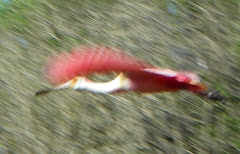Roseate Spoonbills
One thing I love about kayaking in Florida is
occasionally spotting roseate spoonbills, feeding at the water’s
edge, resting in the mangroves, or flying overhead. One of the most
outrageously colored birds of Florida, the roseate spoonbill's rich pink coral color intensifies in winter as mating season approaches. But what appears as a flash of
brilliant pink at first glance is in fact a gradation of color which includes
white plumage, pink, bars of dark cerise, almost red-pink, and a patch of
yellow.
 |
| A roseate spoonbill in the mangroves on Weedon Island FL |
Roseate spoonbills,
along with many other exotic Florida birds, were hunted for their spectacular plumage. The feathers were
used to decorate ladies hats, boas and ornamental fans. The species became so rare in North
America that by the early 1900s there were less than 50 pairs surviving.
Thankfully laws to protect the birds, outlawing collection of the feathers, led
to re-population, mostly by birds moving in from South America. Now there is an
estimated population of more than a thousand pairs.
Spoonbills feed by dipping their bill vertically into the
water and swinging their head from side to side so the long bill can scan a
wide arc for food. Crustaceans such as shrimp, small fish, insects and
small mollusks are the main diet.
 |
| The spoon-shaped bill that gives the bird its name |
Their bill is strangely shaped like a spoon, leading to its
name. Shrimp, rich in carotenoids, gives the feathers their distinctive pink color. Without this component of its diet the feathers stay
white, as they are in young birds
 |
| The strange head of a spoonbill |
Florida Bay is the sea kayaking area where you will most likely
see colonies of roseate spoonbills, but individuals and small groups may be
spotted almost anywhere in Florida. The images here are from Weedon IslandPreserve in Tampa Bay, where you can rent kayaks from Sweetwater Kayaks.
 |
| Flamingos at Seattle Zoo |
Flamingos are often associated with Florida, but mostly they
are only seen as the smaller garden ornament species. Flamingos are related to
spoonbills, and have a similar color plumage resulting from a similar diet.
Flamingos have a very different shaped bill, and they feed with the bill
upside down in the water. Real flamingos are rarely spotted in Florida, and when they are they are most likely to be individuals escaped from parks. If you see a bright flash of pink in the mangroves it will almost certainly be a roseate spoonbill.
For kayaking trips in Southern Florida, check out my book "Guide to Sea Kayaking in Southern Florida", (Globe Pequot Press).

































No comments:
Post a Comment